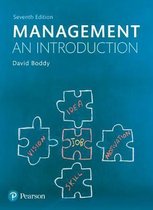Samenvatting
Management an introduction - Boddy Summary Chapter 1,2,3,4,6,7,8,9,10
- Instelling
- Vrije Universiteit Amsterdam (VU)
- Boek
- Management
This Summary is targeted for people studying IMM at the VU Has all the definitions from the book in one big list. All the main topics from the mentioned chapters are included
[Meer zien]





